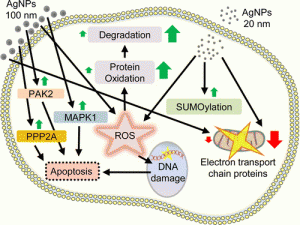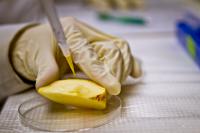Dr Maria Diez-Ortiz, research leader of the NANO-ECOTOXICITY project, tells us about her research findings and how she expects them to help increase knowledge and shape tools allowing for standard environmental hazard and risk-assessment methodologies.
What is the background of the NANO-ECOTOXICITY project?
Nanotechnology is based on the idea that, by engineering the size and shape of materials at the scale of atoms, i.e. nanometres (nm), distinct optical, electronic, or magnetic properties can be tuned to produce novel properties of commercial value. However, there is an obvious concern that such novel properties may also lead to novel behaviour when interacting with biological organisms, and thus to potentially novel toxic effects.
Since nanoparticles (NPs) are similar in size to viruses, their uptake by and transport through tissues are based on mechanisms distinct from those of molecular uptake and transport. Therefore, there is concern that standard toxicological tests may not be applicable or reliable in relation to NPs, hence compromising current risk-assessment procedures.
The majority of research on nano-safety in the environment has so far focused on the aquatic environment. Current research on environmental fate, however, indicates that soils will become the biggest environmental sink for nanoparticles. Following their entry into liquid waste streams, nanoparticles will pass through wastewater-treatment. processes, ending up in waste sludge which may accumulate in the agricultural land where this sludge is often applied.
What are the main objectives of the project?
This project deals with the toxicokinetics – that is, the rate at which a chemical enters a body and affects it – of metal nanoparticles coming into contact with soil-dwelling organisms. The aim is to determine NPs’ fate and effects in terrestrial ecosystems by means of case studies with zinc oxide and silver NPs, which represent different fate kinetics.
The project’s main objectives are to assess the toxicity of metal nanoparticles in soils in the short and long term; the main route of exposure for earthworms and whether it differs from those of ionic metals; and, finally, the influence of the exposure media on metal nanoparticle toxicity.
What is new or innovative about the project and the way it is addressing these issues?
We have been running a long-term study where soils with AgNP [silver nanoparticles] were stored and left to age for up to a year; their toxicity was tested at the start and after three, seven and 12 months of ageing. The results showed that silver toxicity increased over time, meaning that short-term standard toxicity tests may underestimate the environmental risk of silver nanoparticles.
In parallel, we found that organisms exposed to silver nanoparticles in short-term studies accumulated higher silver concentrations than organisms that were exposed to the same mass concentration of ionic silver. However, these NP exposed organisms actually suffered lower toxic effects. This observation contradicts the prevailing assumption in toxicology that the internalised concentration is directly related to chemical concentration at the target site and hence to its toxicity. This observation creates a new paradigm for nano-ecotoxicology.
What is not yet known is whether the accumulated NP metal may in the longer-term ultimately become toxic (e.g. through dissolution and ion release) in cells and tissues where AgNPs may be stored. Should this occur, the high concentrations accumulated may ultimately result in greater long-term toxicity for NPs than for ionic forms. This may reveal these accumulated NPs as internalised ‘time bombs’ relevant to long-term effects and toxicity.
However, it has to be borne in mind that the redicted environmental concentrations resulting from current use of nanoparticles (e.g. results from EU projects like NANOFATE2) are many times smaller than those used in these studies, meaning that such accumulations of nanoparticle-related silver are unlikely to occur in the environment or, ultimately, in humans.
What difficulties did you encounter and how did you solve them?
The main problems encountered relate to the tracking of nanoparticles inside the tissues and soils, as both are complex matrices. The analysis of the particles is a challenge in itself, even when in water, but to get information about their state in these matrices often requires unrealistic exposure concentrations (due to low detection limits of the highly specialised techniques used for analysis) or extraction of the particles from the matrices, which could potentially change the state of the particles.
In this project, I travelled to University of Kentucky to work with Jason Unrine and used gentle water-based extractions of soil samples immediately before analysing them using ‘Field-flow fractionation’ and ‘Inductively coupled plasma mass spectrometry’ to identify the state of nanoparticles in my aged soils.
To look at what form (speciation) of silver and zinc from the nanoparticle exposures could be found inside worms I collaborated with NANOFATE researchers at Cardiff University who fixed and thinly sectioned the worm tissues. I was lucky to be given the time to use specialist facilities like the UK’s Diamond Light Source synchrotron to investigate where and in what form the metals and potential nanoparticles could be found in these tissues.
The main challenge is that as soon as you take nanoparticles out of the manufacturers’ bottle they start changing, particularly when put into environments likes natural soils and waters, or even organisms. Therefore a lot of characterisation is needed during exposure to establish the state of the nanoparticles the organisms have been exposed to and how fast they are changing from pristine particles to dissolved ions, or particles with completely different surfaces.
Technical solutions to characterisation have been found during this short project, but this will remain a logistical challenge for many years to come as the analysis equipment is still very specialised and expensive and therefore not generally available.
What are the concrete results from the research so far?
The project has helped us draw various conclusions regarding the impact of NPs on the environment and how to assess them. First, we now know that soil acidity, or pH, influences the dissolution and toxicity of ZnO nanoparticles [zinc oxide].
Then, we found that toxicity of silver nanoparticles’ increases over time and that the particles’ coating affects their toxicity to soil invertebrates.
As previously mentioned, earthworms exposed to silver nanoparticles for 28 days accumulated higher silver concentrations than earthworms exposed to silver ions, without the excess silver from the nanoparticles having a toxic effect. [emphasis mine] Moreover, soil ingestion was identified as the main route of exposure to AgNP and ZnONP in earthworms.
How can industry and decision-makers ensure that nanomaterials do not impact our environment?
We hope that this project, and the larger EU project NANOFATE to which it is linked, will provide knowledge and tools enabling standard environmental-hazard and risk-assessment methodologies to be applied to engineered nanoparticles (ENPs) with just a few judicious modifications. The current systems and protocols for chemical risk assessment have been developed over decades, and where no novel toxic mechanisms exist, our results tend to say that nano fits in as long as we measure the right things and characterise realistic exposures properly.
Our research aims to determine the minimum methodological tweaks needed. So far everything indicates that the potential benefits from nanotechnology can be realised and managed safely alongside other chemicals. While we are fairly confident at this stage that ENPs impose no greater acute effects on important biological parameters – like reproduction – than their ionic forms, the NANO-ECOTOXICITY results demonstrate that we have some way to go before we can state loud and clear that we do not believe there is any novel low-level or long-term effect.
As for all chemicals, proving such a negative is impossible using short-term tests. We think the final conclusions by industry and regulators on safe use of nanoparticles should and will have to be made according to a ‘weight of evidence’ approach – proving there is a gap between predicted likely exposure levels and those levels seen to cause any effects or accumulations within ecosystem species.
What are the next topics for your research?
This project has finished but the next step for any other funding opportunity would be to address increasingly environmentally relevant exposure scenarios by analysing how nanoparticles modify in the environment and interact with living tissues and organisms at different trophic levels. I would like to investigate nanoparticle transformation and interactions in living tissues. To date, the studies that have identified this ‘excess’ accumulation of non-toxic metal loads in nanoparticleexposed organisms have only been short term.
Apart from the obviously increased food-chain transfer potential, is also not known whether, over the longer term, the accumulated NP-derived metal ultimately becomes toxic when present in tissues and cells. Such transformation and release of metal ions within tissues may ultimately result in greater longterm toxicity for NPs than for ionic forms.
Furthermore, I want to test exposures in a functioning model ecosystem including interspecific interactions and trophic transfer. Since interactions between biota and nanoparticles are relevant in natural soil systems, caution is needed when attempting to predict the ecological consequences of nanoparticles based on laboratory assays conducted with only a single species. In the presence of the full complement of biological components of soil systems, complex NPs may follow a range of pathways in which coatings may be removed and replaced with exudate materials. Studies to quantify the nature of these interactions are therefore needed to identify the fate, bioavailability and toxicity of realistic ‘non-pristine’ forms of NPs present in real soil environments.
New to me was the material about ageing silver nanoparticles and their increased toxicity over time. While this is an interesting piece of information it’s not necessarily all that useful. It seems even with their increased uptake compared to silver ions, silver nanoparticles (Diez-Ortiz doesn’t indicate whether or not * they tested variously aged silver nanoparticles) did not have toxic effects on the earthworms tested.
* ‘not’ removed to clarify meaning, Oct. 9, 2013. (Note: I had on Oct. 8, 2013 removed ‘not’ in a second place from the sentence in an attempt t o clarify the meaning and ended up not making any sense at all.) Please read Maria Diez-Ortiz in the Comments, as she clarifies matters in a way I could never hope to.

